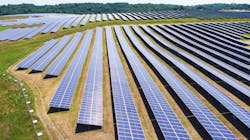Where Trash Turns into Treasure: The Future of Solar on Landfills
According to Wood Mackenzie, the total operating solar capacity in the United States is projected to expand from its present 153 GW to nearly 375 GW by 2028.
But as these projections portray a positive shift in the country’s energy mix, concerns are growing over where these projects will be built.
The Environmental Protection Agency estimates a typical 500 kW to 2,000 kW community solar project will require 3 to 12 acres of cleared land – land that many farmers and communities would prefer to see developed into housing or agricultural projects.
While community solar projects provide a host of benefits to the surrounding areas, such as increased tax revenues, decreased electricity costs, and sustainable job creation, anti-solar sentiments have not abated and continue to impact the rate at which new solar projects are commissioned.
“Community concerns have made it harder for some developers to scale solar projects at the rate that science dictates that we need to,” said David Murray, American Clean Power Association’s Director of Solar Policy.
According to Wood Mackenzie, while 17 GW of utility-scale solar capacity was installed in the U.S. in 2021, an additional 1.7 GW of proposed solar capacity was canceled during the permitting stage.
“For every single large-scale solar project, you’re seeing very well-organized opposition on social media,” said Matthew Sahd, Solar Market Analyst at Wood Mackenzie.
To overcome these growing concerns and continue installing solar projects at a rate that can support the country’s net-zero goals, solar project developers and local governments are turning to an unlikely solution – closed landfills.
Landfills are drawing the attention of solar developers for two main reasons: land availability and land mass.
Most cities and counties own and operate actively managed or closed landfills, meaning solar developers have access to multiple acres of cleared land in almost every part of the country.
Closed landfills lack redevelopment opportunities, meaning solar developers are utilizing land that would otherwise go unused, avoiding land-use conflicts with the community.
Landfills also provide large parcels of land with adequate sun exposure for strong solar irradiation, as well as existing connections to electric distribution infrastructures and access roads for construction, operations, and maintenance tasks. Many federal and state organizations also provide grants and incentives to alleviate additional upfront costs.
These benefits have been so enticing that over the past 10 years, almost 50% of all renewable energy projects on brownfields, or land that is underused due to contamination concerns, were located on landfills. As of the end of 2022, solar landfill had a capacity of 2.4 GW, enough to power nearly half a million homes, and the Rocky Mountain Institute estimates this capacity could grow at least 25-fold in the coming decades.
While many provide prime and relatively inexpensive, although environmentally sensitive, real estate for solar projects, not every landfill is an ideal match. Certain factors must be taken into consideration during the siting process.
For example, the physical condition of the landfill determines whether the location can support a solar infrastructure. This includes factors such as the landfill slope and orientation, the cap depth, and the settlement potential.
Unlike typical solar projects, a capped landfill cannot be punctured to secure the PV systems; instead, developers must utilize a ballasted system. Land settlement can also affect solar installation; as the ground continues to settle over time, solar panels can become misaligned, lowering their solar generation potential.
“There’s more due diligence, there’s more design and engineering, and people’s time that has to go into sufficiently planning this,” said Matthew Popkin, Urban Transformation Manager at Rocky Mountain Institute. “If you put a stake in the grass in a random field poorly, the dirt might suffer. If you put a stake in a landfill poorly, the community might suffer.”
For a candidate landfill to be selected, a preliminary, decision-grade feasibility study must be conducted. If the landfill passes this initial inspection, it is subject to a final investment-grade feasibility study. These feasibility studies are similar in nature, except the investment-grade study requires a more in-depth information collection process followed by rigorous analyses.
Several companies have recently had great success launching solar landfill projects, including DSD Renewable’s 4.3 MW solar project in New York, Coast Energy’s 8.6 MW project in Long Island, and CS Energy’s 10 MW project in New Jersey.
Where many see only acres of unusable space, solar developers are beginning to see potential and the promise of a solution that brings developers, government officials, and local communities together to support the growing energy transition. Through the repurposing of landfills, the solar industry can build an infrastructure ready to support the country’s net-zero goals.
About the Author
Breanna Sandridge, Senior Editor
Breanna Sandridge is senior editor for EnergyTech and Microgrid Knowledge, both part of the energy group at Endeavor Business Media.
Prior to that, Breanna was managing editor for Machinery Lubrication and Reliable Plant magazines, both part of Noria Corp. She has two years experience covering the industrial sector.
She also is a 2021 graduate of Northeastern State University (Oklahoma) with a Bachelor's in English.

